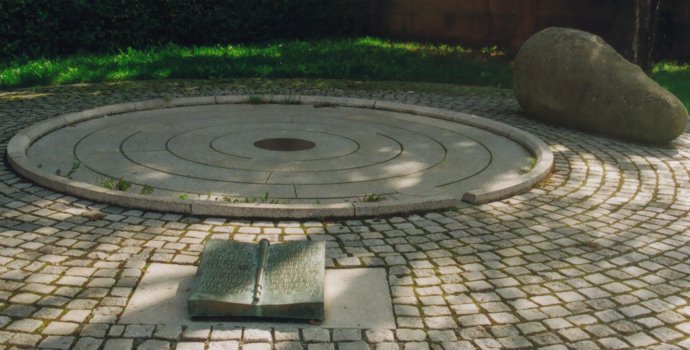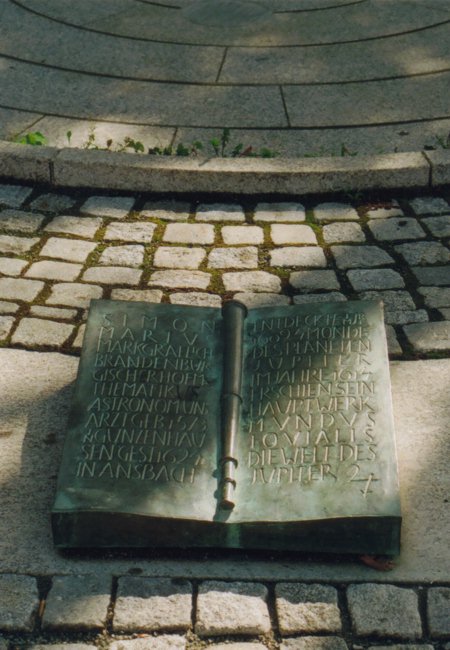

![]() In unmittelbarer Nähe der Markgräflichen Residenz von Ansbach - auf dem
Karl-Burkhardt-Platz - befindet sich ein Denkmal für den Hofmathematikus
Simon Marius. Die wissenschaftlichen
Leistungen von S. Marius werden in [1] skizziert. Dazu gehören
seine von G. Galilei unabhängige Entdeckung der vier großen Jupitermonde nebst
seinen diesbezüglichen Berechnungen sowie seine Übersetzung der ersten sechs
Bücher von Euklids "Elementen".
In unmittelbarer Nähe der Markgräflichen Residenz von Ansbach - auf dem
Karl-Burkhardt-Platz - befindet sich ein Denkmal für den Hofmathematikus
Simon Marius. Die wissenschaftlichen
Leistungen von S. Marius werden in [1] skizziert. Dazu gehören
seine von G. Galilei unabhängige Entdeckung der vier großen Jupitermonde nebst
seinen diesbezüglichen Berechnungen sowie seine Übersetzung der ersten sechs
Bücher von Euklids "Elementen".
Das Denkmal besteht aus einer kreisrunden Fläche mit einer Struktur konzentrischer Kreise, die das Mondsystem des Jupiters darstellt1). Der Planet wie auch seine vier großen Monde sind ausgearbeitet. Dazu gehören noch ein birnenförmiger Felsblock, der - so sagt man - den Kopf / das Gesicht von Simon Marius wiedergeben soll, und eine Tafel etwa in der Gestalt eines aufgeschlagenen Buchs, auf dem mittig ein Fernrohr liegt. Auf den beiden sichtbaren Buchseiten ist folgender Text zu lesen:
| Simon Marius Markgräflich Brandenbur- gischer Hofma- thematikus, Astronom und Arzt, geb[oren] 1573 in Gunzenhau- sen, gest[orben] 1624 in Ansbach, |
entdeckte im J[ah]re 1609 4 Monde des Planeten Jupiter. Im Jahre 1614 erschien sein Hauptwerk 'Mundus Iovialis' - Die Welt des Jupiter |
Dieser Text wird am Ende noch mit dem Symbol des Planeten Jupiter abgeschlossen. Die verwendeten Satzzeichen in diesem Text sind allerdings dazuerfunden - das Original kommt ohne aus. Auf einer steinernen Bodenplatte ist noch ein Hinweis zu lesen, dass das Denkmal vom Lions-Club Ansbach im Jahr 1991 gestiftet wurde. Das Denkmal hat der münchener Künstler Friedrich Schelle entworfen [1].
Die Fotos wurden im August 2008 aufgenommen. Weitere Informationen zu S. Marius sind unter http://www.simon-marius.net/ verfügbar.
1) Nachdem die Aufnahmen auf dieser Seite entstanden sind wurden ergänzend die Darstellungen der Jupitermonde beschriftet (siehe [2]). (Zurück zum Bezug)

![]() Close to the margrave's castle of Ansbach on a place called Karl-Burkhardt-Place
there is a monument commemorating to the court mathematician
Simon Marius.
The scientific work of S. Marius is sketched in [1]. It includes the
discovery of the four Galilean moons of Jupiter independently from G. Galilei and his
associated computations and the translation of the first six books of Euclids
"Elements".
Close to the margrave's castle of Ansbach on a place called Karl-Burkhardt-Place
there is a monument commemorating to the court mathematician
Simon Marius.
The scientific work of S. Marius is sketched in [1]. It includes the
discovery of the four Galilean moons of Jupiter independently from G. Galilei and his
associated computations and the translation of the first six books of Euclids
"Elements".
The monument was built as a circular flat area with a structure of concentric circles, which represents the lunar system of the planet Jupiter. The planet as well as the four big moons are worked out1). Beside there is also a rock, from which it is told that it presents the head and the face of Simon Marius, as well as a tablet in form of an opened book with a telescope separating the two visible pages. This two pages show the following text:
| Simon Marius margraviate Brandenbur gian mathe- matician at the court astronomer and physician, born 1573 in Gunzenhau- sen, died 1624 in Ansbach, |
discovered in the year 1609 4 moons of the planet Jupiter. His principal work 'Mundus Iovialis' - The world of Jupiter - was issued in the year 1614 |
At the end of this text the symbol for the planet Jupiter is shown. Nearby a small plaque on the ground provides the information that the monument was donated by the Lions-Club of Ansbach in 1991. The monument was designed by the artist Friedrich Schelle from Munich [1].
The photographs were taken in August 2008. More information on S. Marius is available on http://www.simon-marius.net/.
1) After these photographs on this page were taken small plaques with the names of the moons are added to the memorial (see [2]). (Back to the reference)
| [1] | Nürnberger Astronomische Gesellschaft, Cauchy-Forum Nürnberg: SIMON-MARIUS-JUBILÄUM 2014, 400 Jahre Mundus Iovialis (1614), Die Entdeckung der großen Jupitermonde durch den fränkischen Astronomen Simon Marius (1573 - 1624) | |
| [2] | Jupiter-Monde beschriftet, Fränkische Landeszeitung, 31.10./1.11.2009, Ansbach 2009 |
| Back to the main page | Created by Wolfgang Volk in January 2010 Last addition on April 20th, 2014 |